Posts Tagged by matt anderson
1957 Cornell-Liberty Safety Car
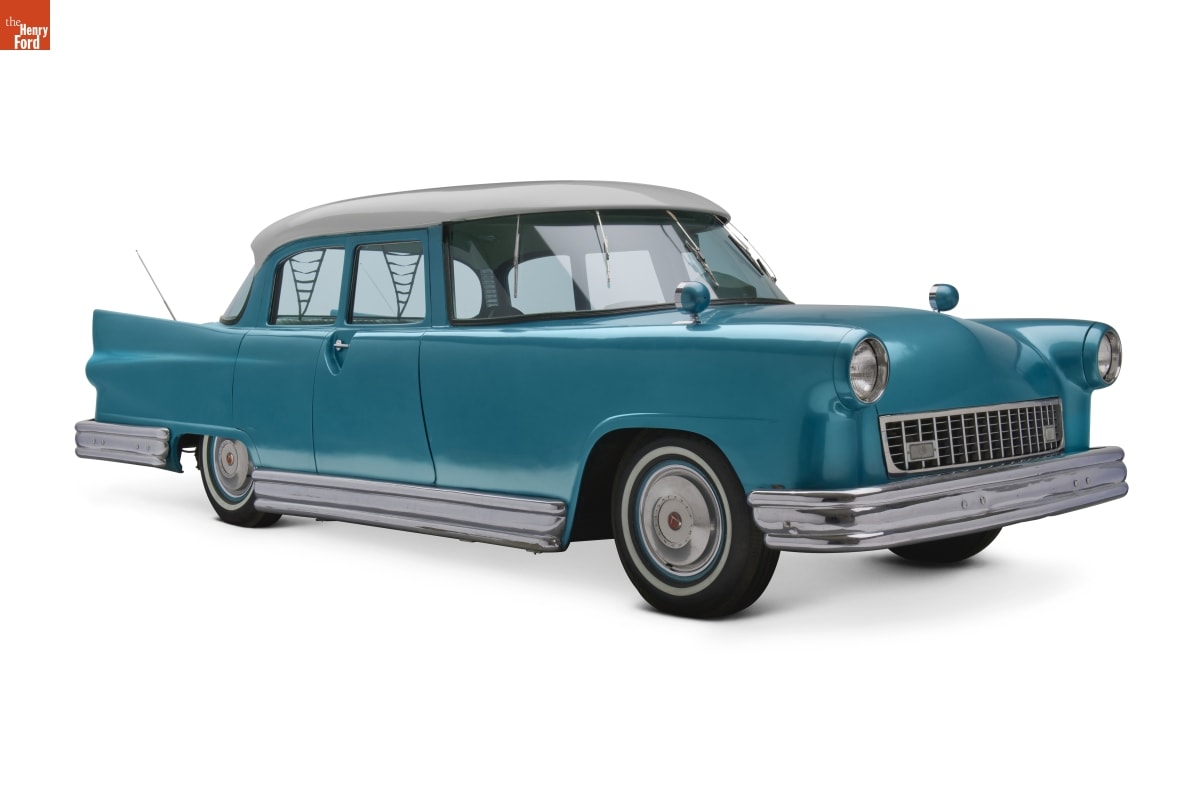
The Cornell-Liberty Safety Car – space age and safety conscious. (THF90867)
We have our share of unusual-looking automobiles in Henry Ford Museum. The Tucker, the Belly Tank Lakester and the Comuta-Car all turn heads. But there’s only one that looks like it just flew in from the Spacely Space Sprockets factory: the 1957 Cornell-Liberty Safety Car. Behind that endearingly odd exterior, though, was a serious five-year effort to save lives by making American cars safer.
Over the first half of the 20th century, many automakers focused their efforts on making cars more reliable, more comfortable and more powerful. Safety was a lesser concern. There were exceptions – laminated windshield glass, which didn’t break into sharp pieces, was in use by the late 1920s – but conventional wisdom held that safety didn’t sell. Customers wanted their cars to be faster, not safer.
By the 1950s, that attitude began to change. Cars were certainly faster by then, but they also had roads to accommodate the higher speeds. State-built turnpikes and federally-funded Interstates had drivers zipping along at 75 miles per hour, and the booming postwar economy put more Americans behind the wheel each year. It’s little wonder that more drivers traveling at faster speeds led to a rise in accidents. By 1950, some 35,000 people were dying in auto accidents each year. Faculty members at Cornell University and officials at Liberty Mutual insurance took notice. In 1951, the two institutions teamed up to research a simple question: What causes injuries in automobile accidents?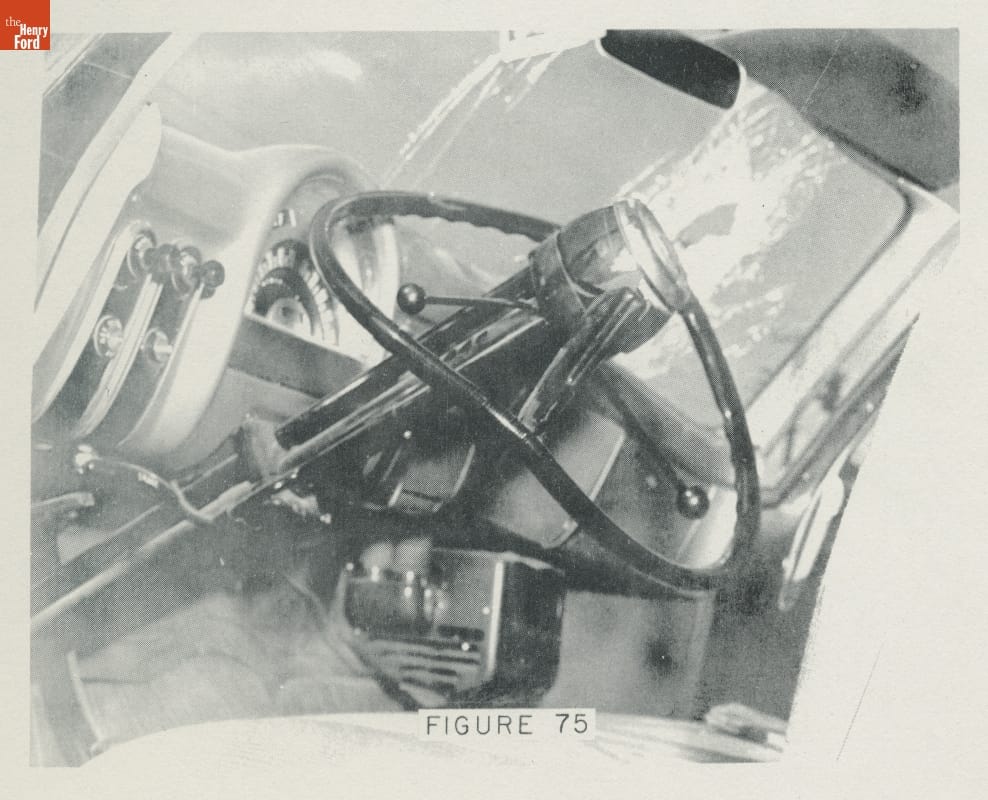 Steering wheels and sharp edges could be lethal. (THF103543)
Steering wheels and sharp edges could be lethal. (THF103543)
America’s highways became a laboratory, and police officers and emergency room doctors became research assistants. By carefully studying accident reports and medical records from around the country, the Cornell-Liberty team made several key discoveries. Car doors were a weak spot. Too often in an accident, a door was smashed open and one or more of the occupants was thrown from the vehicle. Furthermore, the team discovered that someone thrown from a car was more than twice as likely to receive serious injury. They learned that back seat passengers were three times safer than those in the front during a crash.
Researchers determined that the head was the most frequently injured part of the body, and that one in ten victims received a facial disfigurement. Contrary to popular belief at the time, the steering wheel provided no extra protection to the driver. Indeed, the wheel was often a cause of injury, being pushed into a driver’s chest during a crash. What’s more, control knobs, window frames and decorative ornaments often maimed accident victims.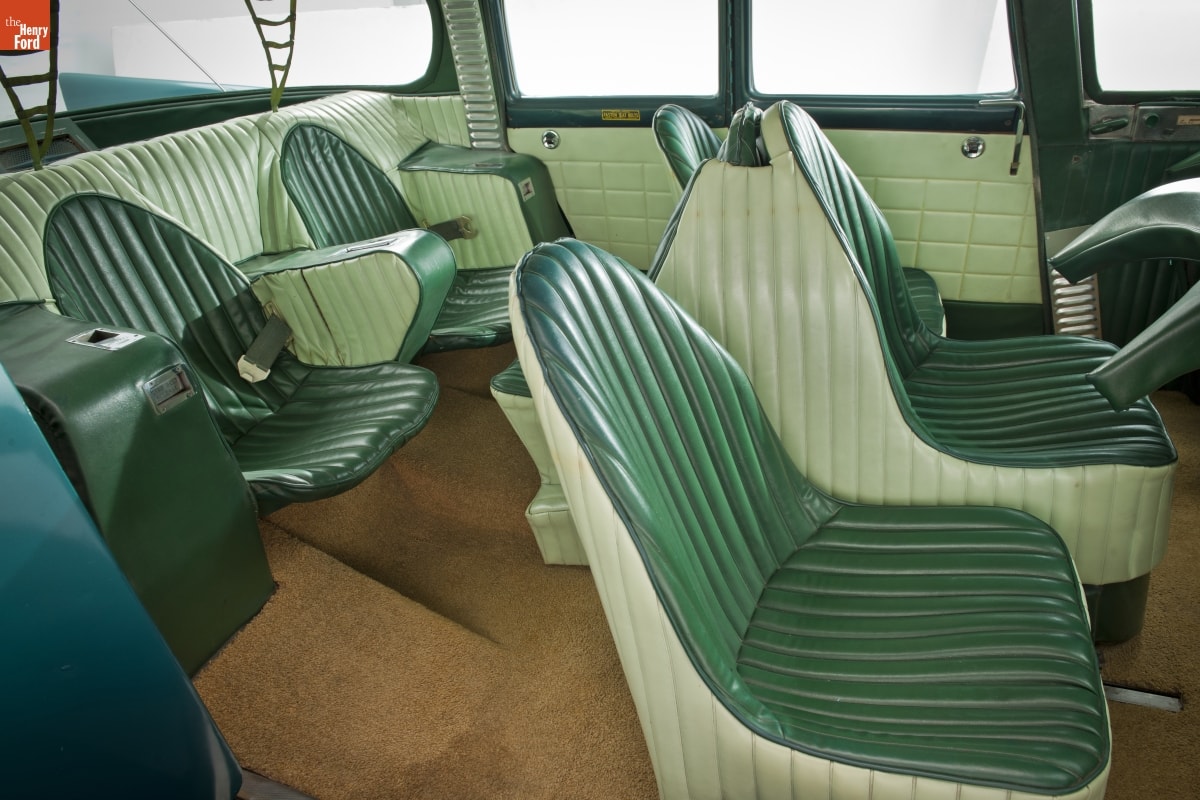 Bucket seats cradle passengers while seat belts keep them secure. (THF90862)
Bucket seats cradle passengers while seat belts keep them secure. (THF90862)
The Cornell-Liberty team put its findings into practice by building a concept car that reduced or eliminated many of these dangers. Working from a 1956 Ford Fairlane, the team produced a car incorporating more than 60 protective features. In effect, they thought of their car like a giant egg carton designed to keep its fragile contents secure. The safety car’s accordion-style doors latched in three places, keeping them closed in a crash. Its bumper wrapped completely around the vehicle, protecting in low-speed accidents. Seat belts were prominent. Head restraints prevented whiplash injuries. The steering wheel and column were replaced by a pair of control handles. The dashboard, like other interior surfaces, was padded. Door handles were recessed. Unnecessary badges and baubles were removed.
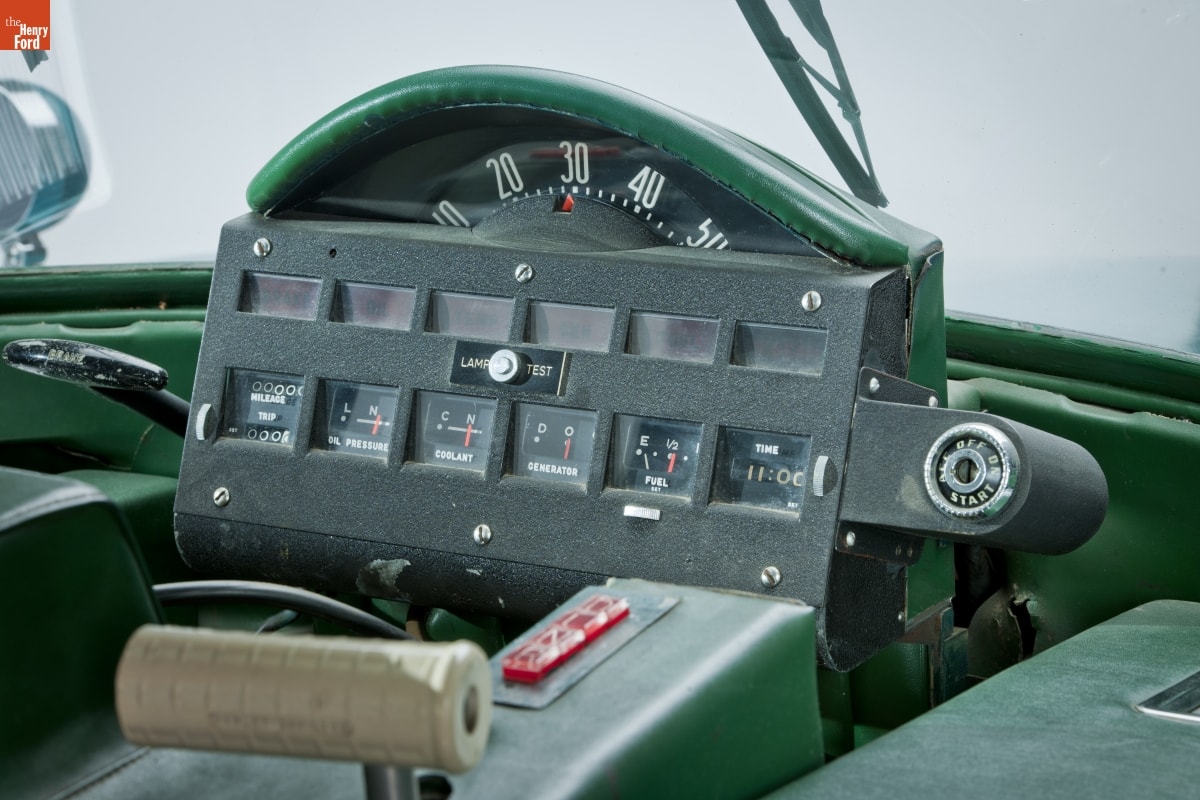 The dashboard is uncluttered and the gauges are easy to read. (THF90865)
The dashboard is uncluttered and the gauges are easy to read. (THF90865)
The best way to survive an accident is to avoid one, so the Cornell-Liberty team took driver visibility and distraction into account. The panoramic windshield – cleaned by five wipers – gave the driver an unobstructed view (as did the driver’s position, in the middle of the car rather than on the left side). Controls were kept to a minimum, and the oversized speedometer dial and gauges were placed directly below the driver’s sightline. The fuel gauge even had a “low level” indicator – something of a novelty in 1957. Indeed, the Cornell-Liberty team seemed to have anticipated every possible distraction; contemporary press reports noted that the offset front seats discouraged “necking while driving.”
Neither Cornell nor Liberty Mutual had any plans to manufacture or sell safety cars, of course. Instead, they hoped that their project would bring more attention to crash protection from the public and – more to the point – from automakers. A decade later, after some additional prodding from Ralph Nader and new government regulations, safety was an established priority in Detroit. And while the car you drive today may not have five windshield wipers or handlebar steering, it’s certainly got a bit of the 1957 Liberty-Cornell Safety Car inside.
Matt Anderson is Curator of Transportation at The Henry Ford.
research, Driving America, Henry Ford Museum, cars, by Matt Anderson
GT40s Land on Pebble Beach for 2016
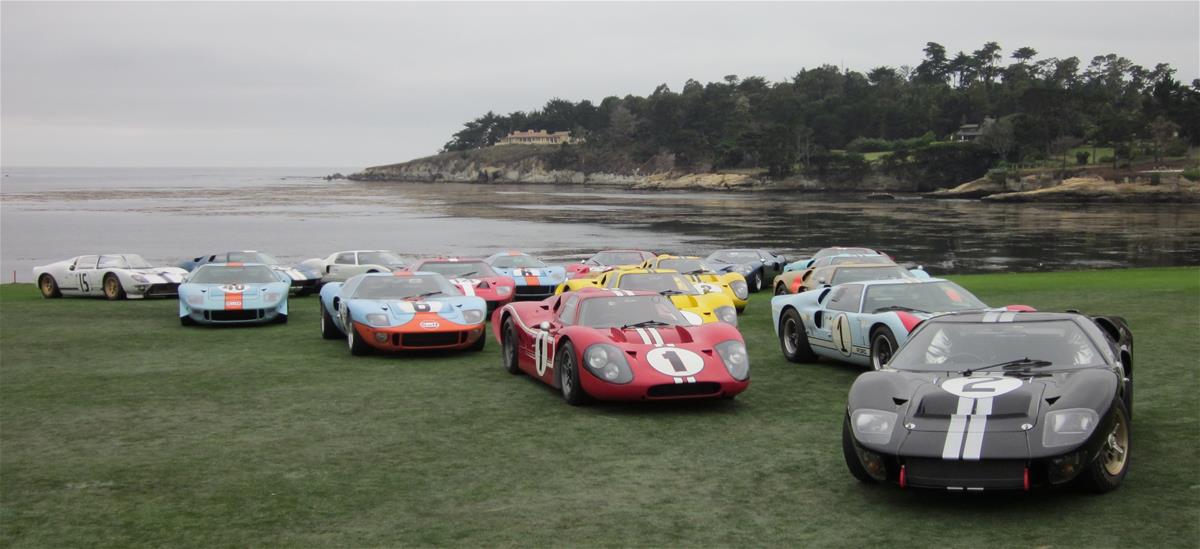
Seventeen Ford GT cars pose for a group portrait on Pebble Beach’s 18th fairway. P/1046, which finished first at Le Mans 50 years ago, leads the pack.
It’s a big year for Ford Motor Company’s iconic GT40 race car. Fifty years ago, New Zealander drivers Chris Amon and Bruce McLaren realized Henry Ford II’s ambitious goal to win the 24 Hours of Le Mans endurance race, while two other GT40s took second and third place. This year, in a bold move, Ford returned to Le Mans with the all-new GT and, in fairy tale fashion, won its class 50 years to the day after the Amon/McLaren victory. Meanwhile, demand for the forthcoming street version of the new GT is so great that Ford just announced it’ll be adding two more production years to the supercar’s limited run. What better time, then, to celebrate the GT40 at the prestigious Pebble Beach Concours d’Elegance?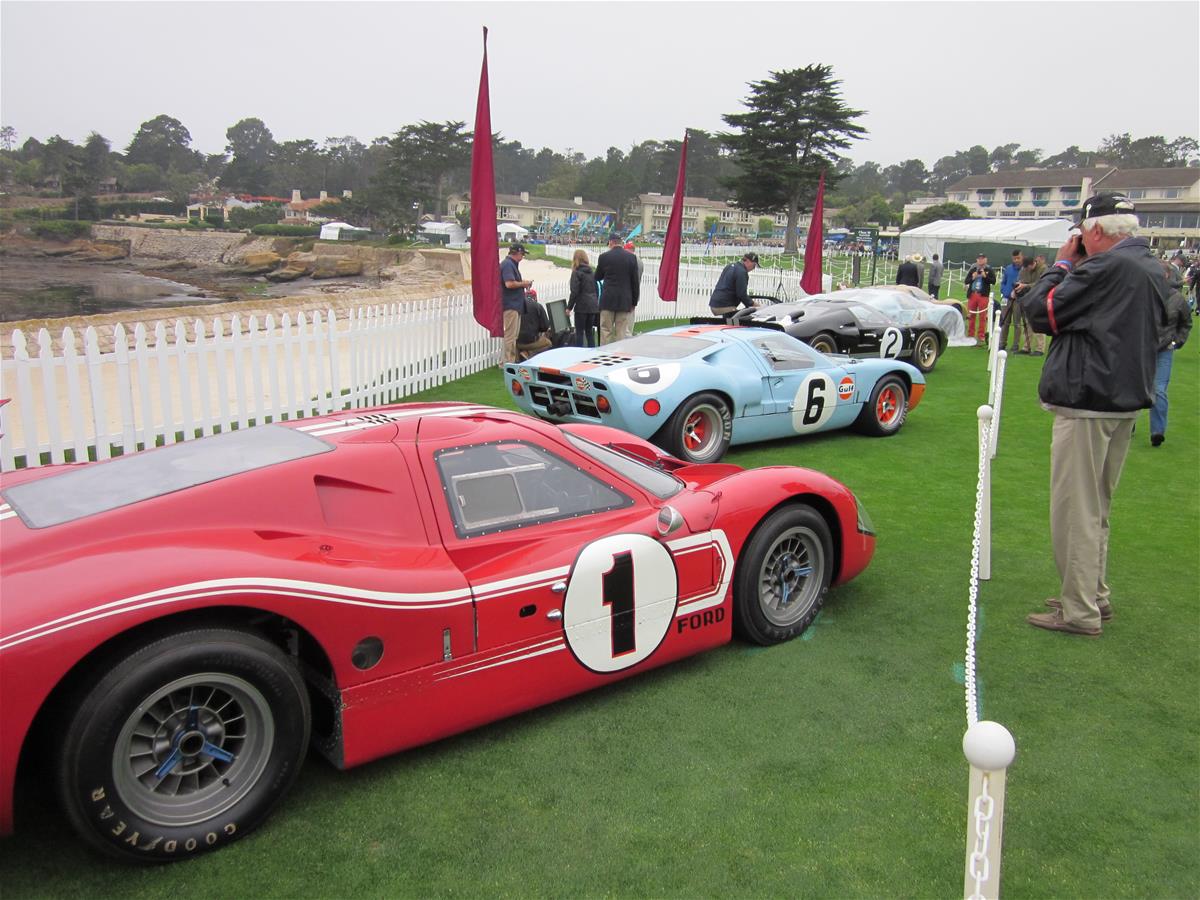 Three cars representing four years of consecutive Le Mans victories: Our Mark IV J-5 (1967), P/1075 (1968-69), and P/1046 (1966).
Three cars representing four years of consecutive Le Mans victories: Our Mark IV J-5 (1967), P/1075 (1968-69), and P/1046 (1966).
Private owners and museums around the world answered the call from Pebble Beach organizers. On August 21, they filled the 18th fairway with what might have been the most impressive collection of Ford GT cars ever assembled outside of the Circuit de la Sarthe. No fewer than 17 GT40s and GT40 variants made the trip to California, and it seemed that every important car was there. There was chassis P/1046, the GT40 Mark II that Amon and McLaren drove to victory in 1966. Freshly – and brilliantly – restored to its race day appearance, the car took “Best in Class” honors from the Pebble Beach judges. Alongside it were 1966’s second and third place cars driven by Ken Miles and Denny Hulme, and Ronnie Bucknum and Dick Hutcherson, respectively.
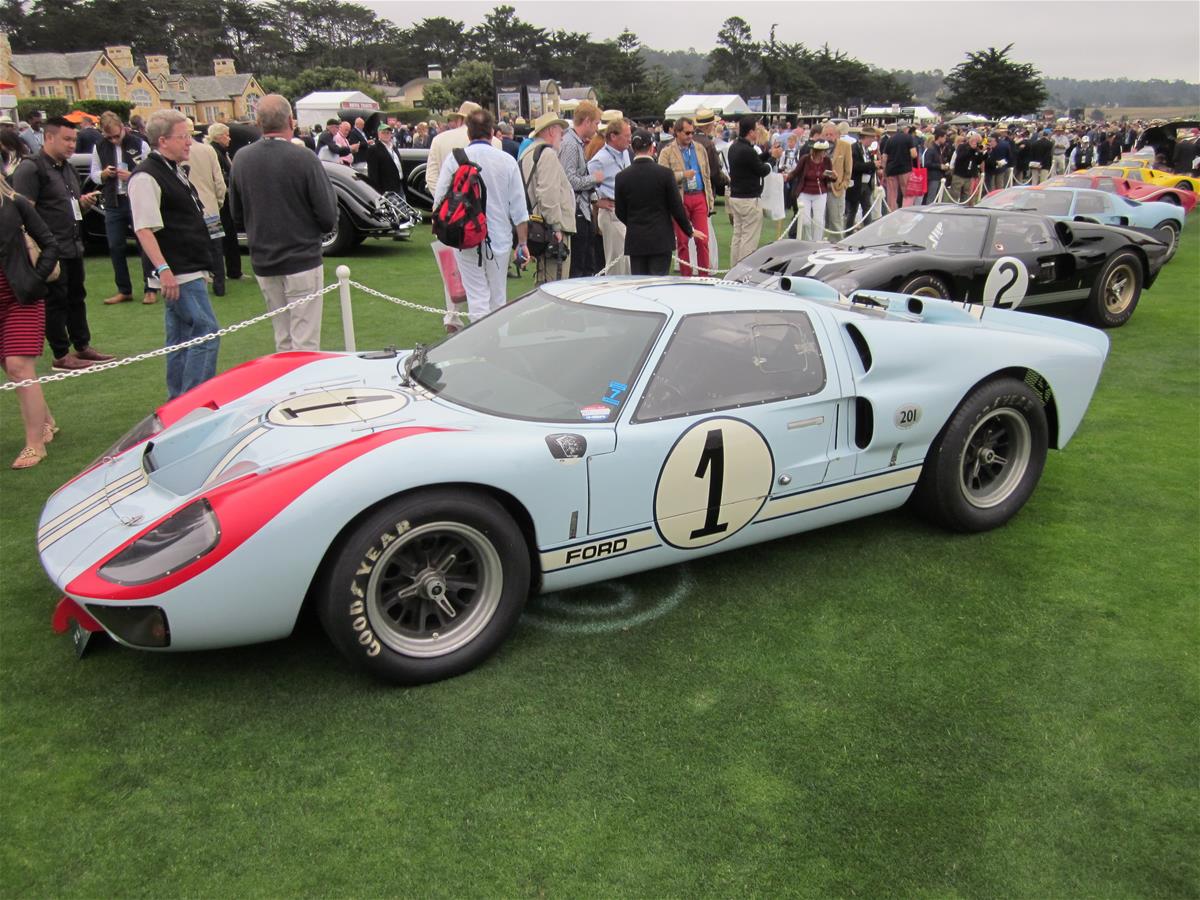 GT40 P/1015 won the 1966 24 Hours of Daytona with Ken Miles and Lloyd Ruby. Four months later, it finished second at Le Mans with Miles and Denny Hulme.
GT40 P/1015 won the 1966 24 Hours of Daytona with Ken Miles and Lloyd Ruby. Four months later, it finished second at Le Mans with Miles and Denny Hulme.
Le Mans winners from other years were present, too. Our Mark IV chassis J-5, of course, won in 1967 with Dan Gurney and A.J. Foyt sharing the driver duties. Then there was chassis P/1075, the GT40 Mark I that won Le Mans twice in a row, with drivers Lucien Bianchi and Pedro Rodriguez in 1968, and with Jacky Ickx and Jackie Oliver in 1969. Ford Motor Company itself pulled out of Le Mans after 1967, but privateer John Wyer did the GT40 proud with those back-to-back victories.
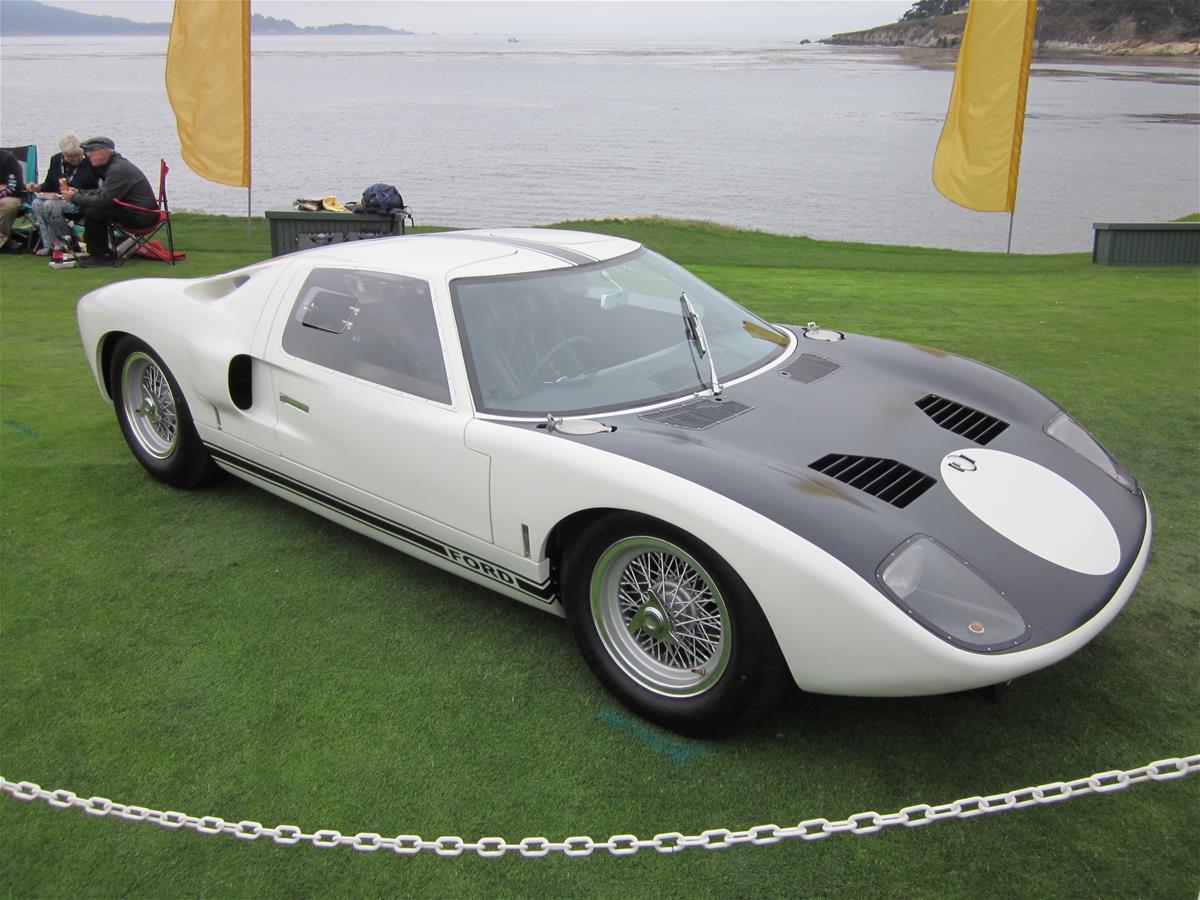 From Switzerland came this replica of GT/101, the very first GT40, which turned heads at the 1964 New York Auto Show.
From Switzerland came this replica of GT/101, the very first GT40, which turned heads at the 1964 New York Auto Show.
Le Mans wasn’t the only race represented at Pebble Beach. Mark IV chassis J-4, which won the 1967 12 Hours of Sebring with Bruce McLaren and Mario Andretti at the wheel, was there on the fairway. So was GT40 P/1074, the Mirage variant which took first place at Belgium’s Spa 1000-kilometer race in 1968 with Jacky Ickx and Dick Thompson. The collection was rounded out with a replica of GT/101, the first-ever GT40, and the prototype 1967 GT40 Mark III that modified the track racer into a more civilized street machine.
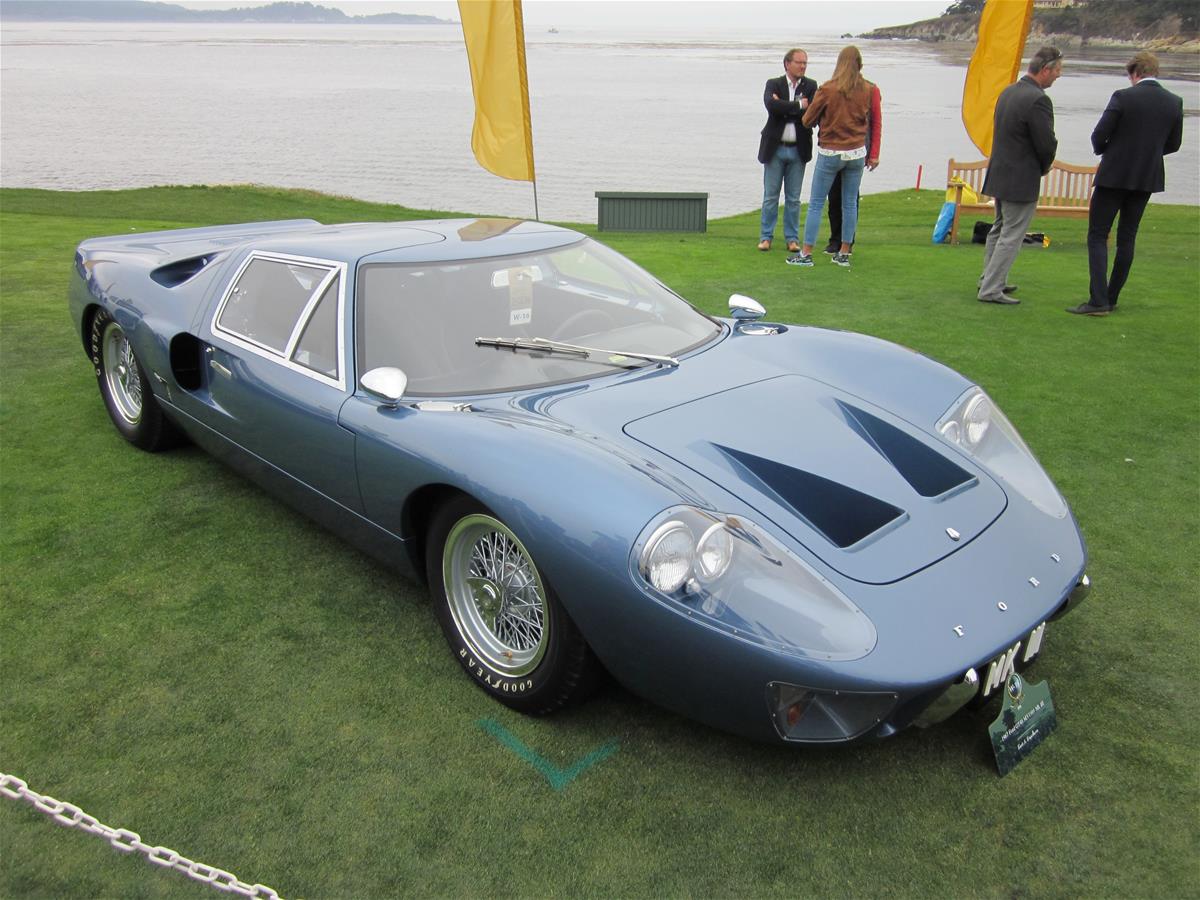 The rare GT40 Mark III. Just seven of these refined road cars were ever built.
The rare GT40 Mark III. Just seven of these refined road cars were ever built.
To put the icing on the cake, the GT40 also featured on this year’s official concours poster. The painting, by noted automotive artist Ken Eberts, features the 1966 trio of 1-2-3 finish cars posed in front of the Lodge at Pebble Beach. Behind the cars stand Carroll Shelby, Henry Ford II and Edsel Ford II. (The younger Mr. Ford not only witnessed the 1966 victory with his father, he was also at Le Mans this year for the 2016 win.)
This year’s Pebble Beach Concours d’Elegance was a once-in-a-lifetime opportunity for fans of the GT40. We were honored to participate with the Mark IV, and we look forward to watching the next chapter of GT history unfold with Ford Performance’s new generation of cars.
Matt Anderson is Curator of Transportation at The Henry Ford.
events, racing, Pebble Beach, Mark IV, Ford Motor Company, cars, car shows, by Matt Anderson
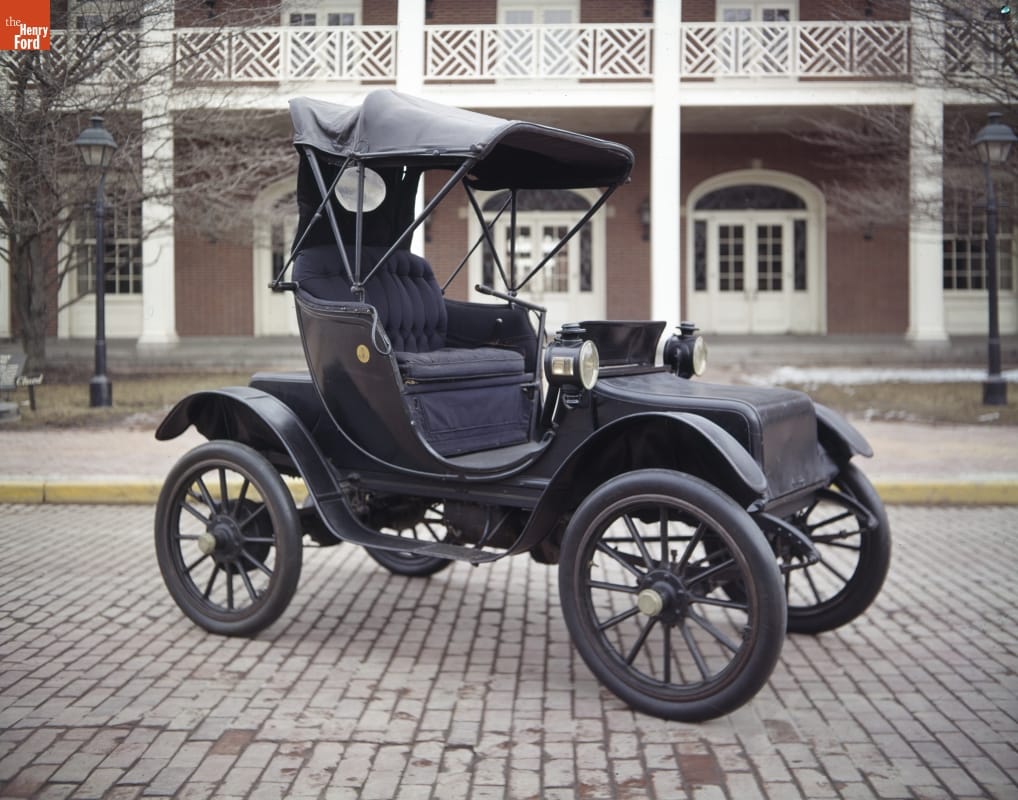
1912 Baker Electric Victoria, used by five first ladies of the United States. THF67884
You might imagine that the White House was an early adopter of the automobile. We think of the presidency as being on technology’s cutting edge. Furthermore, when you realize that progressive Theodore Roosevelt’s term (1901-1909) coincided with the automobile’s rise, it seems natural that the Chief Executive would have made prominent use of the day’s foremost invention. But Roosevelt held fast to the reins and refused to give up his horse-drawn vehicles.
It’s not that Roosevelt avoided cars altogether. He certainly took the occasional car ride while in office, but he refused to bring autos into the presidential transport fleet. This was the era when most people still viewed the automobile as a plaything for the wealthy. It would have damaged Roosevelt’s populist image to have him seen barreling down the street in a motor car. And so it was left to his successor, William Howard Taft, to motorize the White House.
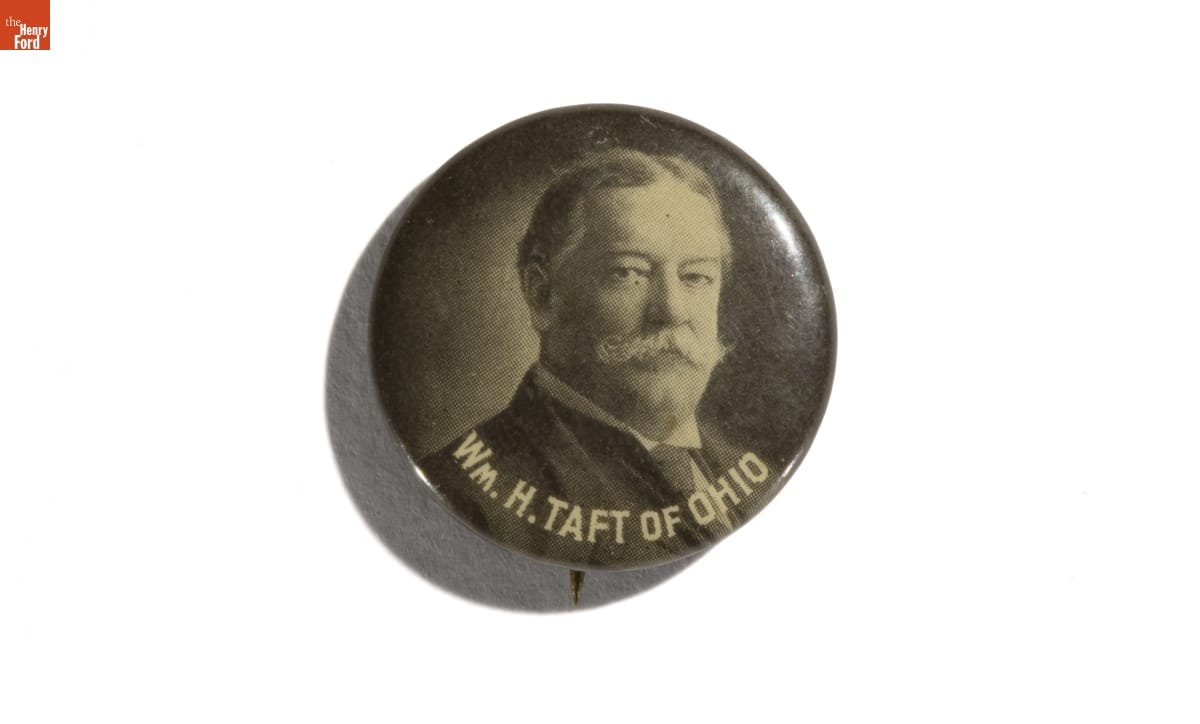
William Howard Taft campaign button. THF155488
Taft did so with gusto, converting the mansion’s stables into a garage and filling it with a White steam car, two gasoline-powered Pierce-Arrows and a Baker electric in 1909. It’s interesting to note that Taft played no favorites when it came to fuel. (The question of which fuel – gasoline, steam or electric – was optimal wasn’t quite settled.) And it seems no coincidence that the Ohio-born Taft favored two carmakers, White and Baker, based in Cleveland.
While the President preferred the White steamer, First Lady Helen Taft chose the Baker as her personal vehicle. Mrs. Taft was not content to be chauffeured around Washington – she drove the Baker herself. Her use of an electric car was perfectly in keeping with the trend for marketing electrics toward prosperous, status-conscious women. Three years later, Mrs. Taft traded in the 1909 model for a new 1912 Baker electric valued at $2000. Records indicate that only $809.50 was paid, so either she received a generous trade-in credit or Baker thought the publicity was worth a substantial discount (or, perhaps, a little of both).
That second Baker, a Victoria model with a gracefully curved body, boasted a top speed of about 30 miles per hour and a range near 50 miles. The little car became a White House fixture. When Woodrow Wilson assumed the presidency in 1913, his wife Ellen and their three daughters drove the Baker. And after Ellen Wilson’s death in 1914, President Wilson’s second wife, Edith, also made use of the Baker. When Warren Harding took office in 1921, First Lady Florence Harding inherited the Baker electric. (The Hardings, like the Tafts, were Ohioans and perhaps took a little Buckeye pride in the Victoria.) And after President Harding’s death in 1923, Calvin Coolidge assumed office and new First Lady Grace Coolidge took to the Baker. By this time, though, the 1912 Baker was outdated in appearance and propulsion. The Baker electric was retired in 1928, and soon thereafter made its way to The Henry Ford.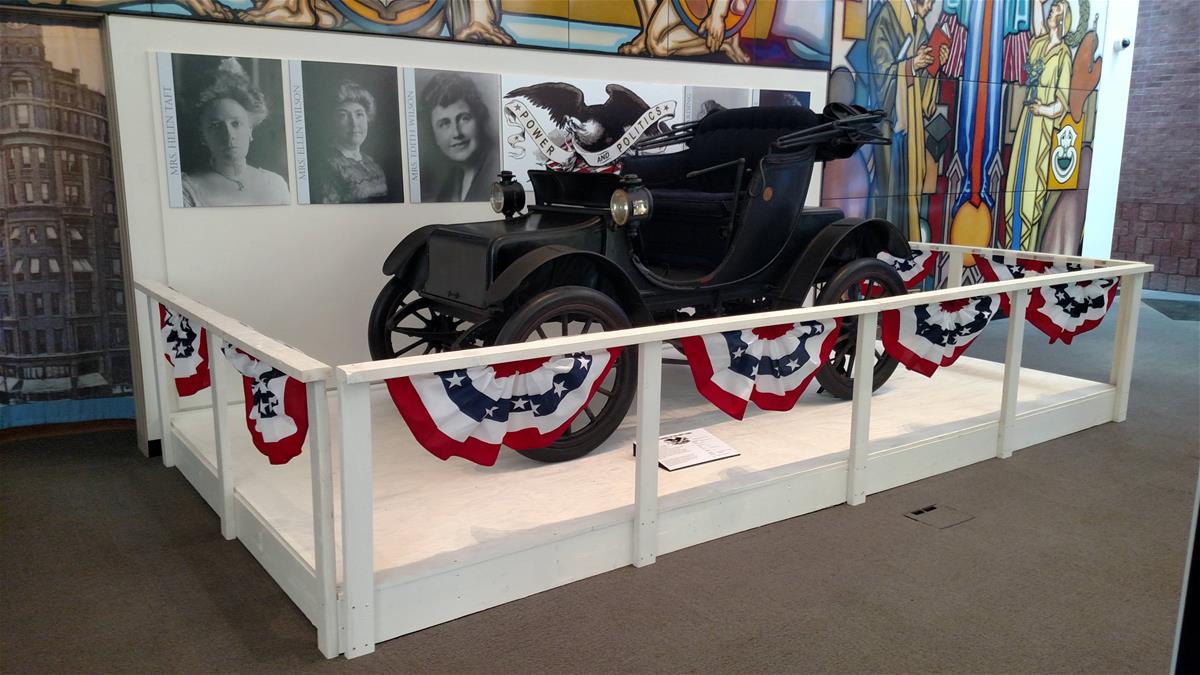
Our Baker has now gone back to Cleveland, its city of manufacture. For the next year, it will be on loan to the Crawford Auto-Aviation Museum of the Western Reserve Historical Society. The loan begins just as the nation’s political spotlight turns to Cleveland with the Republican National Convention, scheduled for July 18-21, 2016. It’s quite fitting: the convention is a major milestone on the road to the White House, and that’s a road the Baker has traveled many times before.
Continue Reading1920s, Washington DC, 20th century, 1910s, women's history, presidents, presidential vehicles, cars, by Matt Anderson, alternative fuel vehicles

Bruce McLaren and Chris Amon won the 1966 24 Hours of Le Mans in the #2 Ford GT40 Mark II. THF252433
Fifty years ago this month, Ford Motor Company earned one of its most memorable racing victories: a stunning 1-2-3 finish at the 24 Hours of Le Mans endurance race. No win in that famed French contest comes easily, and Ford’s arrived only after two years of struggle and disappointment. But that story is among the most interesting in motorsport.
There was Ford’s failed bid to buy Ferrari in 1963, which left Chairman and CEO Henry Ford II determined to beat the Italian automaker on the race track. There was British designer Eric Broadley, whose sleek Lola GT Mark VI car inspired the design of Ford’s Le Mans car, the GT40. There was Carroll Shelby, the larger-than-life designer and team manager who turned around Ford’s struggling program. And there were drivers like Ken Miles, who gave everything – including his life – to the effort.
It all culminated with New Zealander drivers Bruce McLaren and Chris Amon standing on the podium with Henry Ford II on June 19, 1966, having proved that Ford Motor Company could build race cars as good as – better than – any in the world. As if to prove that the win wasn’t a fluke, Ford came back to do it again in 1967, this time with American drivers – Dan Gurney and A.J. Fort – in an American-designed and built car – the Mark IV.
In recognition of the 50th anniversary of Ford’s first Le Mans victory (and, not incidentally, on the eve of Ford’s return to that race), we’ve produced a short film on the 1967-winning Ford Mark IV and the bumpy road that led to it. It’s a story that’s always worth retelling, but especially in a milestone year like this.
Continue Readingby Matt Anderson, Ford Motor Company, race car drivers, racing, cars, race cars, Mark IV, Le Mans
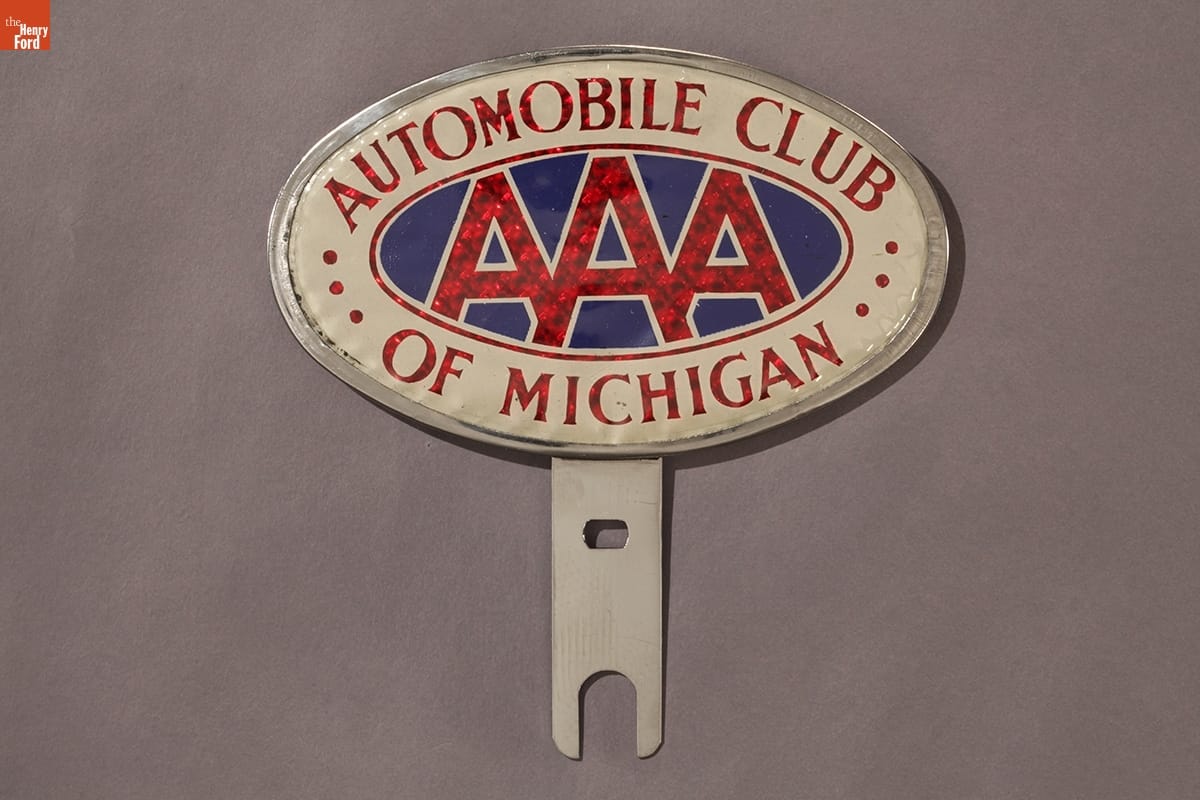
AAA of Michigan Reflector Badge. THF153478
This month, AAA of Michigan commemorates 100 years of serving motorists in the Great Lakes State. It’s an impressive milestone. The first automobile clubs were founded in 1899, not long after the automobile itself debuted on American streets. These original groups were social and political organizations that arranged auto tours, lobbied for car-friendly legislation, and encouraged road and highway improvements throughout the United States. Their work did much to change the car from a plaything for the wealthy into an everyday necessity.
In time, these clubs evolved into non-profit service organizations that, under the national umbrella of the American Automobile Association (established in 1902), printed road maps, created hotel guides, sponsored driver safety programs, offered automobile insurance, and provided roadside assistance to their members. Until the mid-1950s, AAA even sanctioned automobile races, including the Indianapolis 500.
As of 2016, AAA is comprised of 69 member clubs across the country. AAA of Michigan is located right here in Dearborn, not far from The Henry Ford’s campus. In honor of the anniversary, enjoy a few of the AAA of Michigan-related pieces in our collection.
Matt Anderson is Curator of Transportation at The Henry Ford.
roads and road trips, travel, Michigan, cars, by Matt Anderson, AAA
Presidential Limousines at The Henry Ford
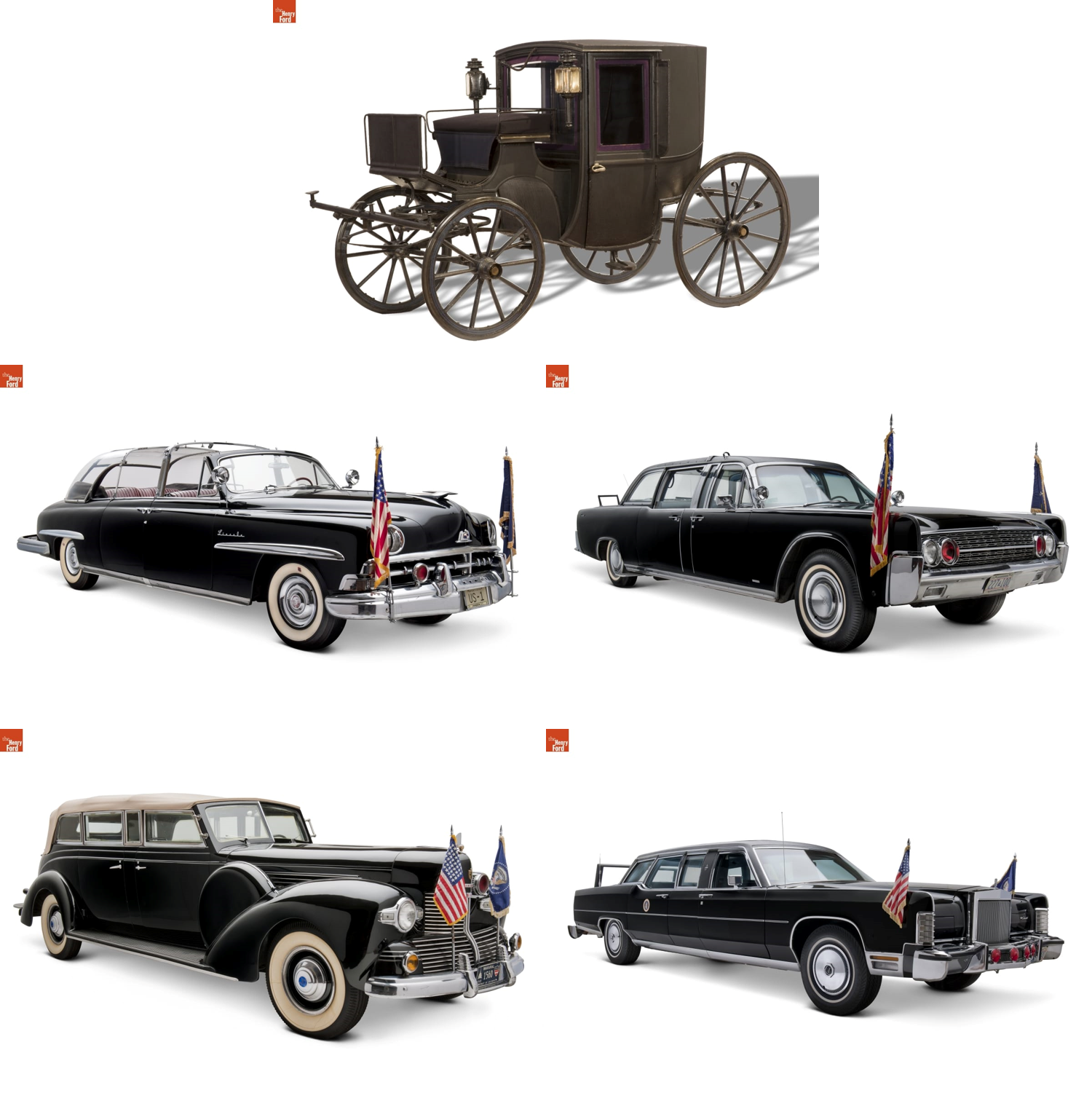
The Henry Ford was excited to once again welcome author and former Secret Service Agent Clint Hill, along with journalist Lisa McCubbin, to Henry Ford Museum this spring in celebration of his latest book, Five Presidents: My Extraordinary Journey with Eisenhower, Kennedy, Johnson, Nixon, and Ford.
More about Mr. Hill and our presidential limousines:
Clint Hill on Presidential Limousines
Presidential Vehicles
Looking Back: JFK Remembered at Henry Ford Museum
Protecting our Presidents
Turning Point

In honor of Mr. Hill's visit to The Henry Ford, Curator of Transportation Matt Anderson put together this overview of the presidential limousines found within on exhibit at Henry Ford Museum. Learn more below.
A presidential parade car provides two things: visibility and security. Those concepts are often at odds. The Henry Ford’s presidential Lincolns illustrate the difficult and changing balance between the chief executive’s need to be seen and need to be safe.
“Sunshine Special,” the 1939 Lincoln Model K most often associated with Franklin D. Roosevelt, was the first parade car specifically modified for presidential use. Coachbuilder Brunn & Company focused more on utility than luxury, deleting armrests for maximum seating capacity and adding wide running boards for Secret Service agents. The car was not armored until Pearl Harbor, when bullet resistant tires, glass and armor plating were installed.
In 1950, Harry S. Truman took delivery of a new Lincoln with a body by Raymond Dietrich, but the car was used most often by successor Dwight D. Eisenhower. Again there was no armor, but in 1954 the limo received the weatherproof plexiglass roof that inspired its nickname, the “Bubbletop.” Security features did not extend much beyond riding steps on the rear bumper and flashing red lights at the front.
Planning for the next car started under Eisenhower, but the 1961 Lincoln Continental limo is forever tied to John F. Kennedy. Once again, armor was not considered necessary, and Kennedy preferred to travel with the top removed whenever possible. But his assassination ended the tradition of open cars. Ford and custom car builder Hess & Eisenhardt rebuilt the 1961 Lincoln with a permanent roof, titanium armor and bullet-resistant glass five layers thick.
The 1972 Lincoln limousine was the first presidential parade car designed and built as an armored vehicle from the start. Security was now of prime importance – a point dramatically underscored when Ronald Reagan suffered an attempt on his life while getting into the limo in 1981.
The Henry Ford’s presidential Lincolns were leased to the White House. As the leases ended, the cars returned to Ford Motor Company and the firm gifted them to the museum. Currently, Cadillac supplies the president’s state cars. Each is custom-built – most recently on truck platforms – and each is typically destroyed at the end of its service life.Matt Anderson is Curator of Transportation at The Henry Ford.
Additional Readings:
- Looking Back: JFK Remembered at Henry Ford Museum
- The Henry Ford's Innovation Nation: Presidential Limousines
- Morgan Gies: Driver to the Presidents
- Protecting Our Presidents
20th century, presidents, presidential vehicles, limousines, JFK, Henry Ford Museum, Ford Motor Company, convertibles, cars, by Matt Anderson

1949 Mercury Convertible, “kustomized” by George and Sam Barris.
Few names loom as large in the world of custom cars as that of George Barris. Mr. Barris, who passed away last November, will forever be associated with the many television and movie cars built by his Los Angeles shop – none more famous than the 1966 Batmobile, adapted from the 1955 Lincoln Futura concept car. But these high-profile cars were just one part of his work. Before Hollywood came knocking, George and his brother Sam had already built a reputation for their imaginative work with other cars, particularly the 1949-1951 Mercury models so loved by first-generation customizers. Indeed, just months before George Barris’s death, several Barris Mercurys were featured at the 2015 Pebble Beach Concours d’Elegance.
We are fortunate to have a Barris Mercury custom – or “kustom,” as Barris invariably spelled it – in the collections of The Henry Ford. Our 1949 Mercury features a chopped windshield; a padded, removable Carson top; frenched headlights and taillights; dechromed surfaces; and prominent “Barris” crests on the front fenders. For a Barris job of the 1950s, the modifications are mild, but sometimes less is more. The color is a deep metalflake purple, with lavender scallops. The scheme continues in the interior, upholstered in purple and white. In the “anything goes” spirit of the custom car hobby, there’s even a little Chevrolet in our Merc – the grille is out of a 1957 Corvette.
Our Barris ’49 Mercury isn’t all Blue Oval. There’s a bit of Bow Tie in that grille.
The 1949-1951 Mercurys, in stock form, were styled a bit behind the times. Their fenders and small windows looked dated next to other postwar cars – especially alongside their sister 1949 Fords. But those old lines appealed to southern California customizers. Lower the roof and suspension, and you turned a staid sedan into a head-turning – almost intimidating – street machine. Mercury customizers were also fond of removing chrome (famously excessive on production cars of that era), substituting parts from other cars, and applying deep, dark paints to the dramatic bodies. Radical or outlandish modifications hadn’t yet caught on in the field. Customizers essentially tweaked their cars to bring out a natural beauty that they already saw.
Our Mercury, then, is a classic example of these influential custom cars. It’s the perfect symbol for the customizer’s craft in Driving America, and a fitting tribute to one of the best-known “kustomizers” in the business.
Continue ReadingCalifornia, 1950s, 20th century, 1940s, making, convertibles, cars, by Matt Anderson
Shell Eco-marathon Americas Returns to Detroit
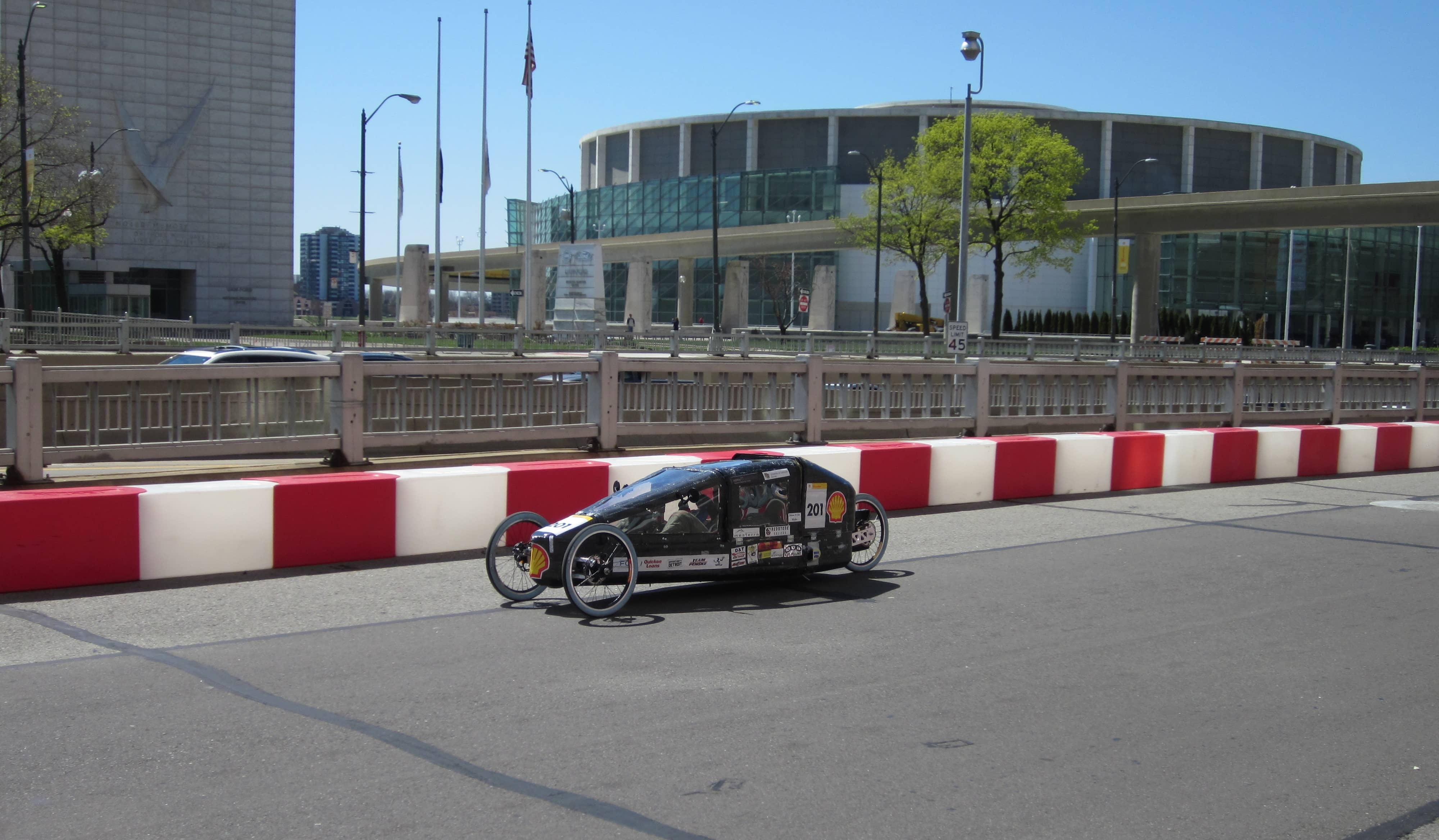
A hydrogen-fueled Prototype from Colorado’s Wheat Ridge High School charges up Jefferson Avenue at the 2016 Shell Eco-marathon Americas.
The gas mileage in our cars is nothing to sneeze at these days. The average for all new light-duty vehicles sold in the United States is around 25 miles per gallon. Buy a gas/electric hybrid like the Toyota Prius or the Chevrolet Volt and the equivalent mileage jumps to about 60. Go with the all-electric Tesla Model S and you’re looking at an equivalent of almost 90 miles per gallon. Good numbers, but you’d have to multiply them by ten to be taken seriously at the Shell Eco-marathon Americas.
For the second year in a row, Shell brought its super-mileage competition to Detroit. More than 1,000 students on 124 teams from high schools and colleges throughout the Western Hemisphere gathered in the Motor City April 22-24 to compete toward a simple goal: to tease as much mileage out of a gallon of gasoline (or its equivalent) as possible.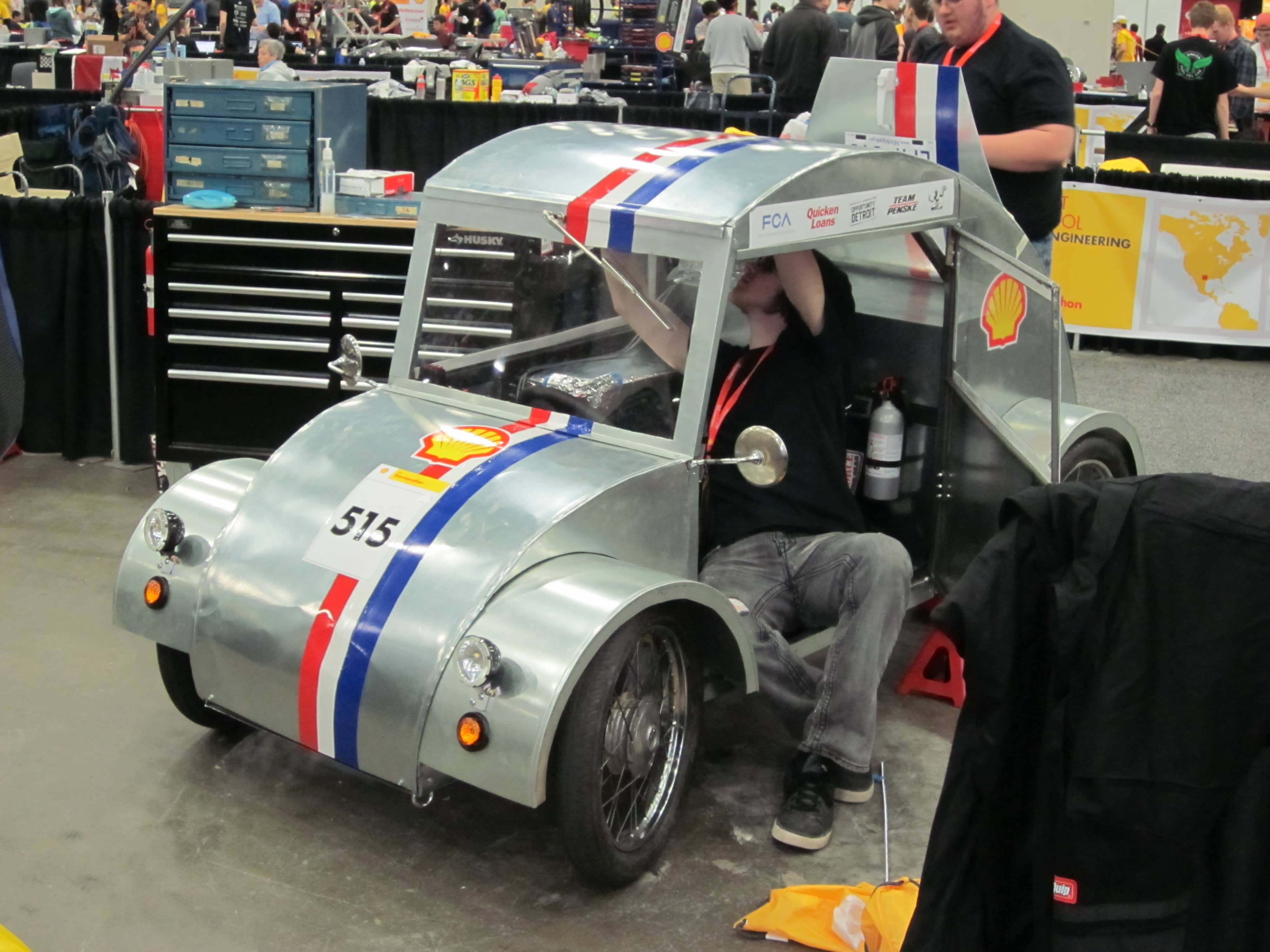
Students from Michigan’s Lapeer County Education and Technology Center are fans of The Love Bug, judging by their Urban Concept vehicle.
If you’re fan of The Henry Ford’s Innovation Nation, then you might recall that the competition was featured in the show. Cars compete in two classes. The Prototypes are stripped-down, highly aerodynamic designs, while the Urban Concept vehicles look a bit more like production cars. Teams may use either internal combustion engines (fueled by gasoline, diesel, natural gas or ethanol) or electric motors (fed by lithium-based batteries or hydrogen fuel cells.) This year’s overall winner was Université Laval of Quebec City with 2,584 miles per gallon. Fellow Canadians from the University of Toronto weren’t far behind with 2,364. California Polytechnic State University rounded out the podium with 1,125. (Complete results are available here.)
How do teams achieve these extraordinary numbers? Streamlined shapes and lightweight materials are big parts of the equation, but the teams also shut off their engines and coast as much as possible along the 0.6-mile course laid out through downtown Detroit. But competing vehicles have to maintain an average speed of at least 15 miles per hour over ten laps, so they can’t rely too heavily on momentum.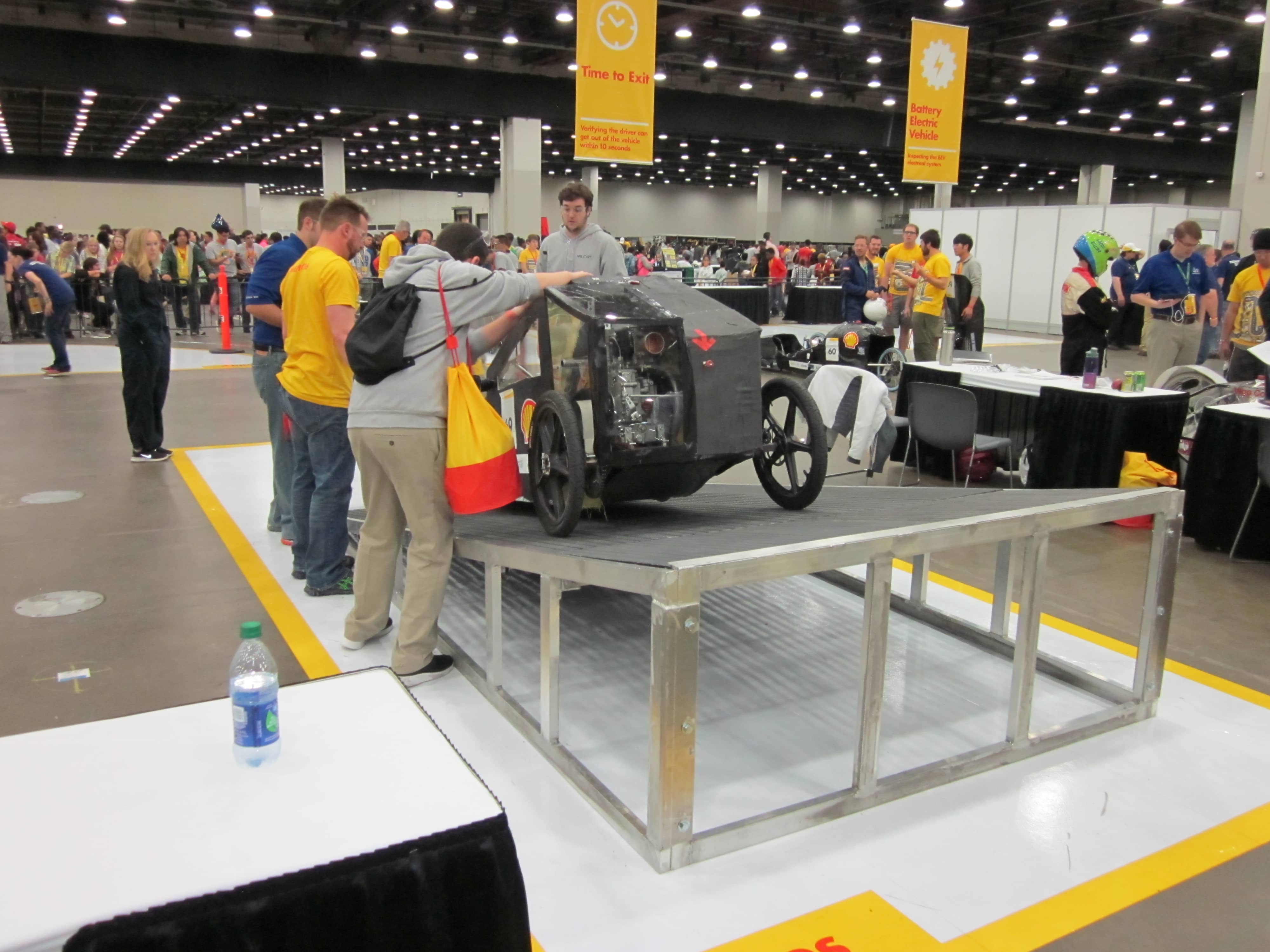
Inspection is rigorous. Many teams struggle with the brake test, in which their car’s brakes must hold the vehicle (with driver) perfectly still on a 20-percent grade.
It’s an all-in commitment for the students. Teams began arriving in Detroit on Tuesday, and most of them stayed in tents set up on Cobo Center’s lower level. If they weren’t sleeping or competing on the track, odds are that the students were working on their cars in the paddocks that covered much of Cobo’s main hall. Each vehicle has to pass a rigorous safety and compliance inspection before it’s allowed on the track, so there’s always fine-tuning to be done.
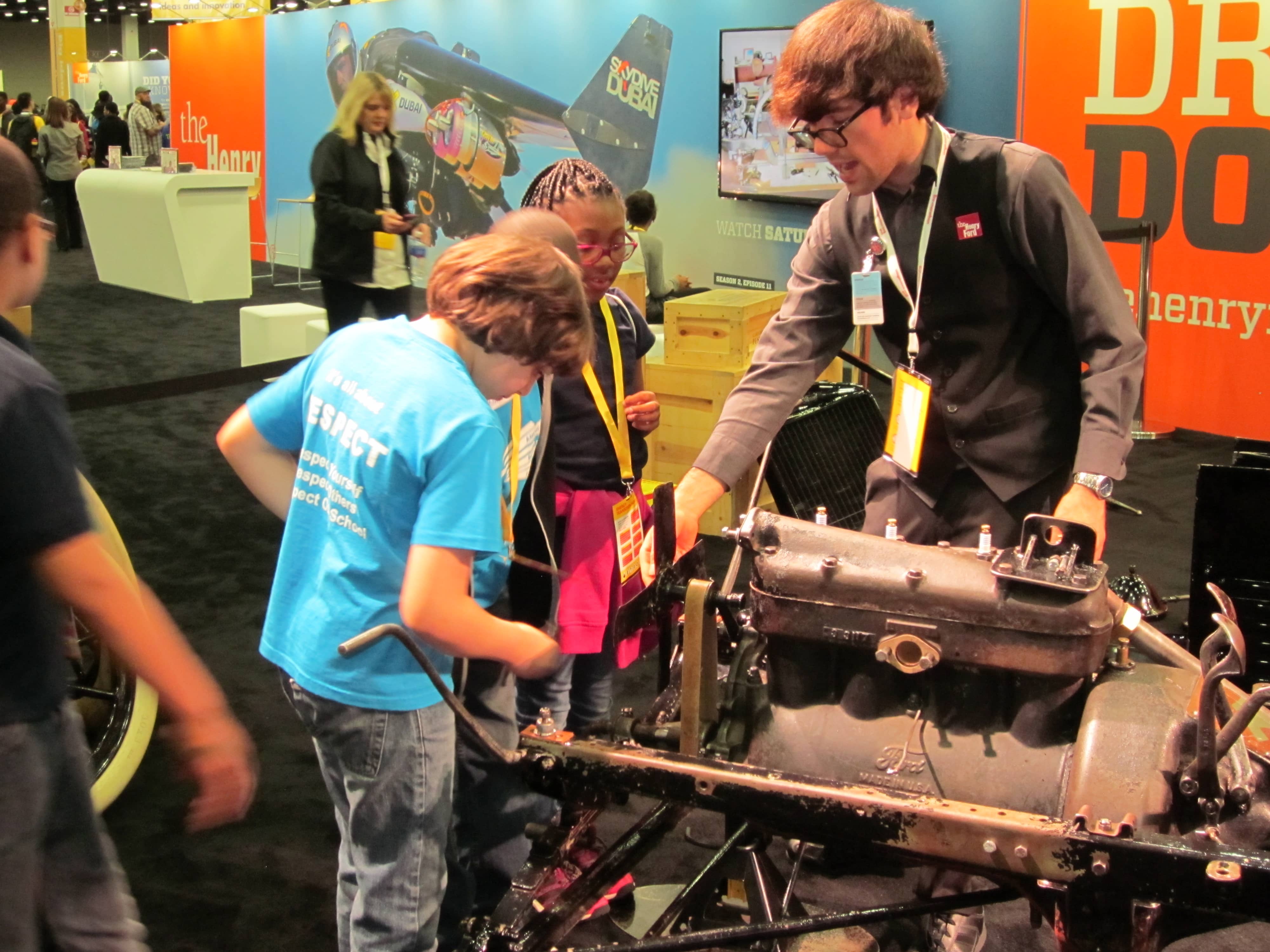
Everybody loves to build a Model T.
In addition to the competition, there were many other attractions for the public to enjoy. The Henry Ford was pleased to have a presence in Cobo Center alongside the Michigan Science Center, the MotorCities National Heritage Area, FCA and other organizations. We brought two of our signature experiences – the “Build a Model T” activity and the operating replica of Henry Ford’s Kitchen Sink Engine – along with the replica of the 1896 Quadricycle and the 102.5 mile-per-gallon Edison2 X Prize car. We also brought several auto-related clips from The Henry Ford’s Innovation Nation to inspire the teams and event visitors alike.
On Saturday, I was privileged to moderate a panel discussion with students and staff from Maxwell High School of Technology in Lawrenceville, Georgia. The group won the grand prize in Quaker State’s 2015 Best in Class Challenge, in which they had six weeks to turn a plain-vanilla 2003 Chevrolet Impala into a head-turning street machine. The competition, with its tight time and money restrictions, gave the students a new appreciation for teamwork – not unlike the cooperation that is so crucial to Eco-marathon teams.
The Shell Eco-marathon Americas will be back in Detroit in 2017. If you missed the event this year, be sure to get to Cobo Center next time to enjoy one of the most exciting and innovative motor vehicle challenges around.
Matt Anderson is Curator of Transportation at The Henry Ford.
events, Michigan, Detroit, environmentalism, education, childhood, by Matt Anderson, cars, alternative fuel vehicles
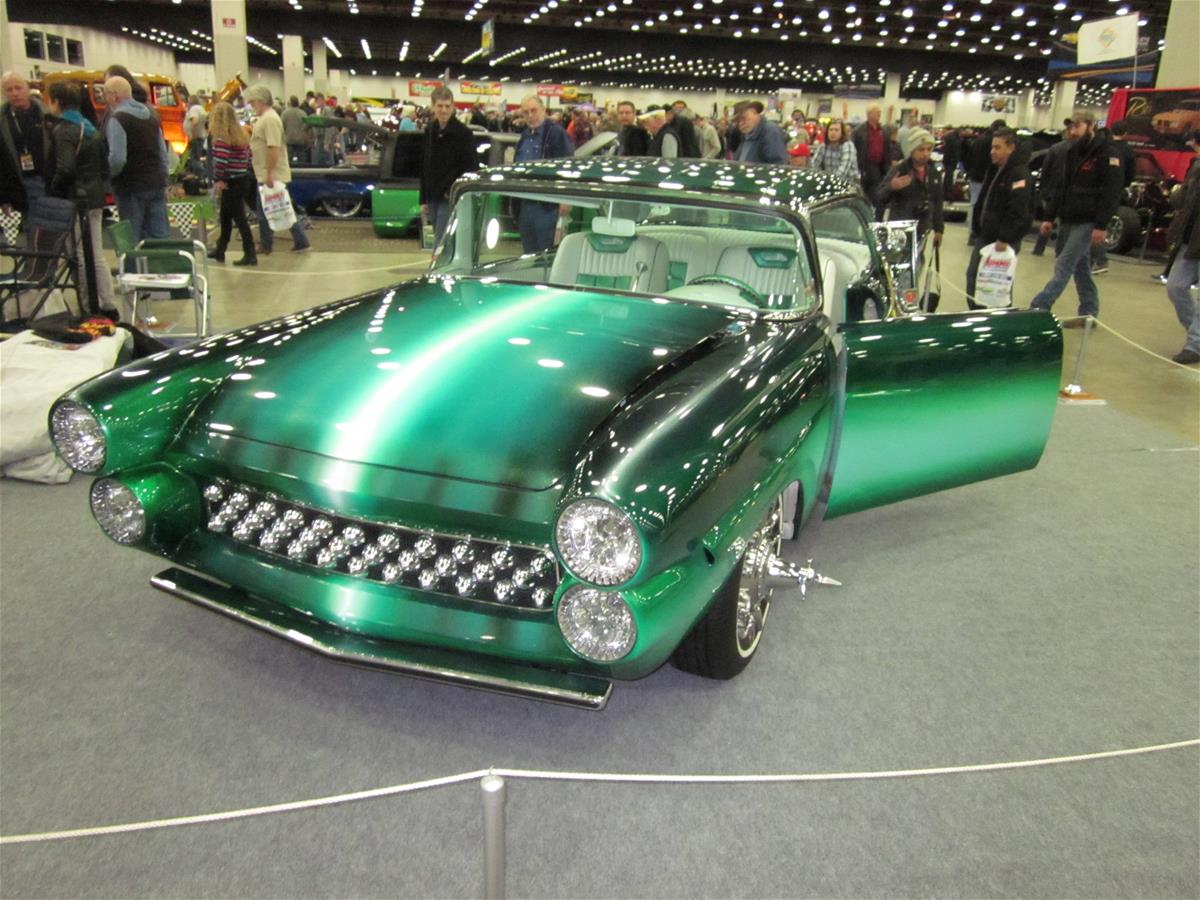
Even in the dead of winter, it’s never a long wait around here for the next car show. Soon after the North American International Auto Show closes its doors, we look forward to the Detroit Autorama, the annual show featuring the best in custom cars and hot rods. The 2016 show, held February 26-28, did not disappoint with some 800 vehicles spread over 750,000 square feet in Cobo Center.
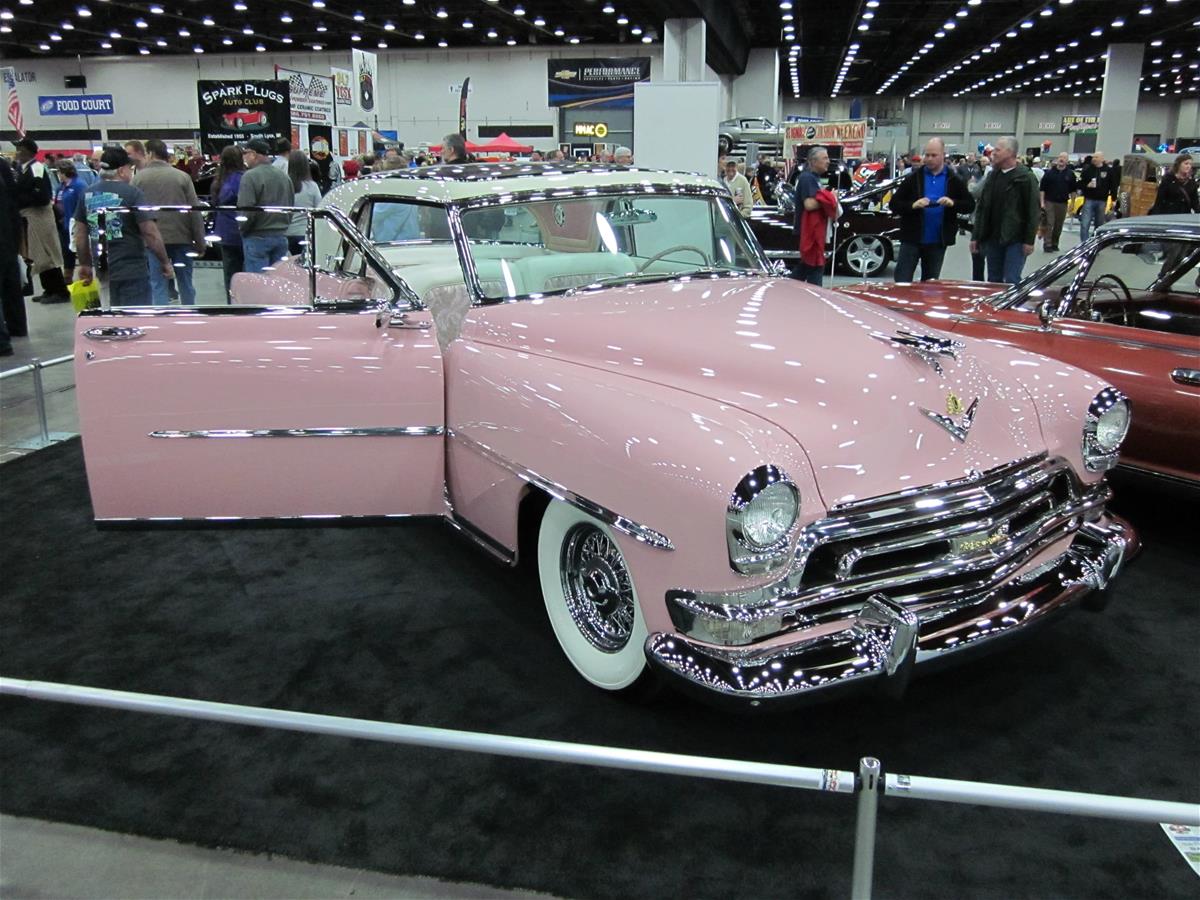
21st century, 2010s, Michigan, Detroit, cars, car shows, by Matt Anderson, Autorama
Engines Exposed: 2002 Toyota Prius

When we look at an automobile, we are moved by what we see on the outside – its styling. But what moves the car is on the inside – its engine. Please join us for a rare look under the hoods of some of the finest automobiles at Henry Ford Museum. More than 40 cars have their engines exposed for you.
Here, Matt Anderson, Curator of Transportation at The Henry Ford, describes some of his favorites.

Engines Exposed: 2002 Toyota Prius
Gasoline Engine: Inline 4-cylinder engine, double overhead cam, 91 cubic inches displacement, 76 horsepower
Electric Motor: AC, permanent magnet, 33 kilowatt, 44 horsepower
Hybrid cars are an old idea, but their moment arrived with the Toyota Prius. The car’s gas and electric power plants sit side-by-side. The electrical inverter, on top of the electric motor, converts DC current from the batteries into AC used by the motor. That motor becomes a generator during braking, turning kinetic energy from the car’s momentum into electricity fed back to the batteries.
electricity, hybrid cars, alternative fuel vehicles, Driving America, Henry Ford Museum, by Matt Anderson, Engines Exposed, engines

